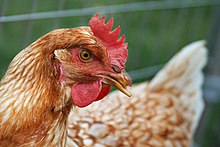
Beak trimming (also spelled as beak-trimming; informally as debeaking), or beak conditioning, is the partial removal of the beak of poultry, especially layer hens and turkeys, although it is also be performed on some quail and ducks. When multiple birds are confined in small spaces due to farming practices, they are more likely to hurt each other through pecking. Beak trimming aims to avoid damage done by pecking, although the practice is criticized by animal welfare organizations and banned in several European countries. Beak trimming is most common in egg-laying strains of chickens. In some countries, such as the United States, turkeys routinely have their beaks trimmed. In the UK, only 10% of turkeys are beak trimmed.[1]
In close confinement, cannibalism, feather pecking and aggression are common among turkeys, ducks, pheasants, quail, and chickens of many breeds (including both heritage breeds and modern hybrids) kept for eggs. The tendency to cannibalism and feather pecking varies among different strains of chickens, but does not manifest itself consistently. Some flocks of the same breed may be entirely free from cannibalism, while others, under the same management, may have a serious outbreak. Mortalities, mainly due to cannibalism, can be up to 15% in egg laying flocks housed in aviaries,[2] straw yards,[3] and free-range systems.[4] Because egg laying strains of chickens can be kept in smaller group sizes in caged systems, cannibalism is reduced[5][6] leading to a lowered trend in mortality as compared to non-cage systems. Cannibalism among flocks is highly variable and when it is not problematic, then mortalities among production systems are similar.[5]
Opponents of beak trimming state that the practice reduces problem pecking by minor amounts compared to the trauma, injury, and harm done to the entire flock by beak trimming. Several countries have banned the practice, including Denmark (2013), Finland (1986), Germany (2017),[7] the Netherlands (2019),[8] Norway (1974) and Sweden (1988); analysts expect other European countries such as the UK to follow in the near future.[9][10] Alternatives to beak trimming include enrichment or providing more space for the birds.
- ^ "Beak-trimming". Archived from the original on 2011-11-30. Retrieved 2011-11-11.
- ^ Hill, J.A., (1986). Egg production in alternative systems - a review of recent research in the UK. Research and Development in Agriculture, 3: 13-18
- ^ Gibson, S.W., Dun, P. and Hughes, B.O., (1988). The performance and behaviour of laying fowls in a covered strawyard system. Research and Development in Agriculture, 5: 153-163
- ^ Keeling, L.J., Hughes, B.O. and Dun P., (1988). Performance of free range laying hens in a polythene house and their behaviour on range. Farm Building Progress, 94: 21-28
- ^ a b Appleby, M.C. and Hughes B.O., (1991). Welfare of laying hens in cages and alternative systems: Environmental, physical and behavioural aspects. World's Poultry Science Journal, 47: 109-128
- ^ Abrahamsson, P. and Tauson, R., (1995). Aviary systems and conventional cages for laying hens - effects on production, egg quality, health and bird location in 3 hybrids. Acta Agriculturae Scandinavica Section A-Animal Science, 45: 191-203
- ^ "Ab 2017 bleibt der Schnabel jetzt bundesweit dran!". Archived from the original on 2015-04-14. Retrieved 2016-02-24.
- ^ Cite error: The named reference
Venhuizenwas invoked but never defined (see the help page). - ^ Cite error: The named reference
Sandilandswas invoked but never defined (see the help page). - ^ Cite error: The named reference
Eppwas invoked but never defined (see the help page).